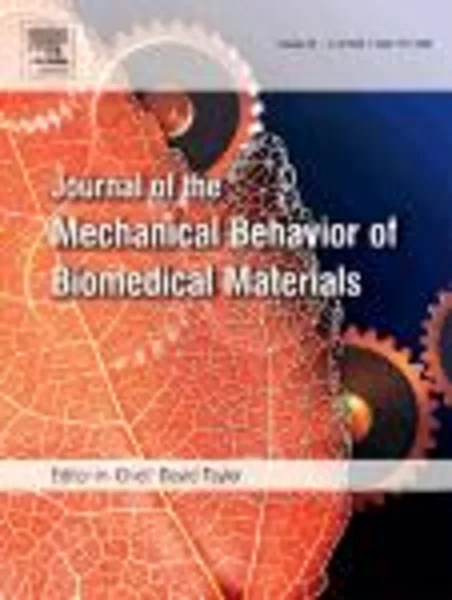-
a mesostructurally-based anisotropic continuum model for biological soft tissues—decoupled invariant formulation
جزئیات بیشتر مقاله- تاریخ ارائه: 1394/01/01
- تاریخ انتشار در تی پی بین: 1394/01/01
- تعداد بازدید: 741
- تعداد پرسش و پاسخ ها: 0
- شماره تماس دبیرخانه رویداد: -
characterising and modelling the mechanical behaviour of biological soft tissues is an essential step in the development of predictive computational models to assist research for a wide range of applications in medicine, biology, tissue engineering, pharmaceutics, consumer goods, cosmetics, transport or military. it is therefore critical to develop constitutive models that can capture particular rheological mechanisms operating at specific length scales so that these models are adapted for their intended applications. here, a novel mesoscopically-based decoupled invariant-based continuum constitutive framework for transversely isotropic and orthotropic biological soft tissues is developed. a notable feature of the formulation is the full decoupling of shear interactions. the constitutive model is based on a combination of the framework proposed by lu and zhang [lu, j., zhang, l., 2005. physically motivated invariant formulation for transversely isotropic hyperelasticity. international journal of solids and structures 42, 6015–6031] and the entropic mechanics of tropocollagen molecules and collagen assemblies. one of the key aspects of the formulation is to use physically-based nanoscopic quantities that could be extracted from experiments and/or atomistic/molecular dynamics simulations to inform the macroscopic constitutive behaviour. this effectively couples the material properties at different levels of the multi-scale hierarchical structure of collagenous tissues. the orthotropic hyperelastic model was shown to reproduce very well the experimental multi-axial properties of rabbit skin. a new insight into the shear response of a skin sample subjected to a simulated indentation test was obtained using numerical direct sensitivity analyses.
مقالات جدیدترین رویدادها
-
استفاده از تحلیل اهمیت-عملکرد در ارائه الگوی مدیریت خلاقیت سازمانی و ارائه راهکار جهت بهبود
-
بررسی تاثیر ارزش وجوه نقد مازاد بر ساختار سرمایه شرکت های پذیرفته شده در بورس اوراق بهادار تهران
-
بررسی تأثیر سطح افشای ریسک بر قرارداد بدهی شرکت های پذیرفته شده در بورس اوراق بهادار تهران
-
بررسی تأثیر رتبه بندی اعتباری مبتنی بر مدل امتیاز بازار نوظهور بر نقد شوندگی سهام با تأکید بر خصوصی سازی شرکت ها
-
تأثیر آمیخته بازاریابی پوشاک ایرانی بر تصویر ذهنی مشتری پوشاک ایرانی (هاکوپیان)
-
مقایسه تاثیر انواع الیاف بر مشخصات بتن
-
تحلیل دینامیکی پل های مورب با سخت کننده های طولی تحت بارهای متحرک به روش نوار محدود به منظور تعیین ضرایب تقویت دینامیکی
-
گزارش 1 مورد شوانوما با تظاهر توده زبانی
-
blind bolted moment connection to unfilled hollow section columns using extended t-stub with back face support
-
effects of y2o3 nanoparticles on growth behaviors of cu6sn5 grains in soldering reaction
مقالات جدیدترین ژورنال ها
-
مدیریت و بررسی افسردگی دانش آموزان دختر مقطع متوسطه دوم در دروان کرونا در شهرستان دزفول
-
مدیریت و بررسی خرد سیاسی در اندیشه ی فردوسی در ادب ایران
-
واکاوی و مدیریت توصیفی قلمدان(جاکلیدی)ضریح در موزه آستان قدس رضوی
-
بررسی تاثیر خلاقیت، دانش و انگیزه کارکنان بر پیشنهادات نوآورانه کارکنان ( مورد مطالعه: هتل های 3 و 4 ستاره استان کرمان)
-
بررسی تاثیر کیفیت سیستم های اطلاعاتی بر تصمیم گیری موفق در شرکتهای تولیدی استان اصفهان (مورد مطالعه: مدیران شرکتهای تولیدی استان اصفهان)
-
محدودیت فروش کوتاه مدت و خطر سقوط قیمت سهام با تاکید بر کارایی سرمایه گذاری
-
طراحی الگوی فرایند دانش آفرینی در دانشگاه بر اساس رویکرد آمیخته
-
بررسی اثر اقتصاد سیاسی پشت سر استقلال بانک مرکزی
-
خسارت ناشی از تأخیر در تحویل کالا و خسارات معنوی و اقتصادی در خصوص حمل و نقل دریایی
-
ارتباط بین استقرار مدیریت دانش و توانمندسازی با عملکرد شغلی کارکنان




سوال خود را در مورد این مقاله مطرح نمایید :